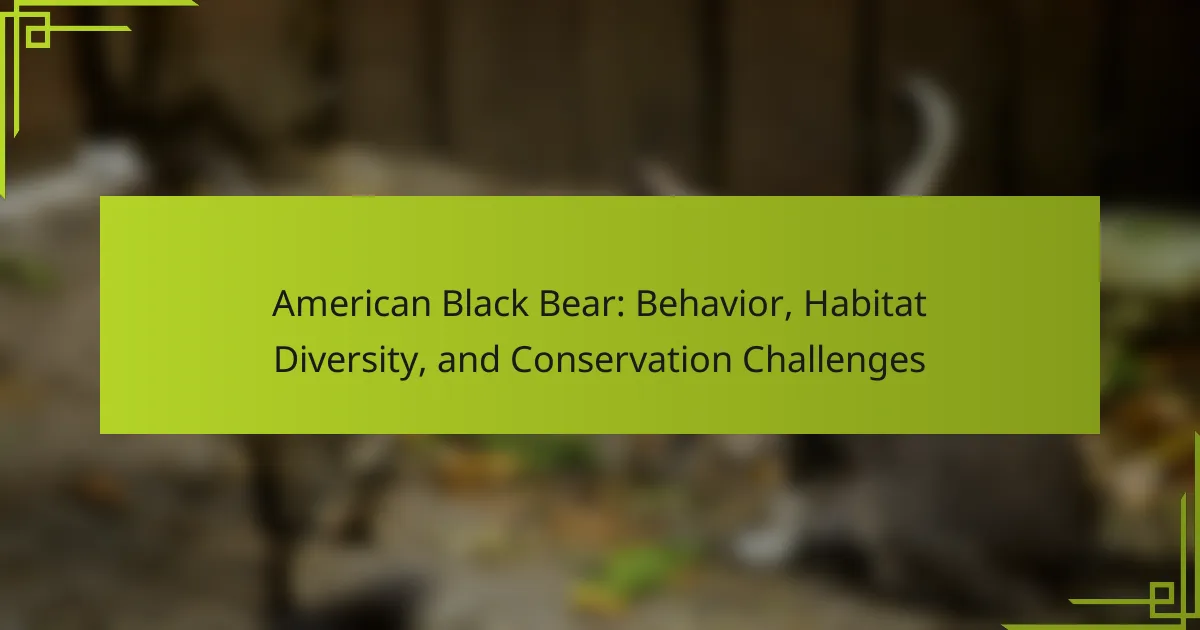The American Black Bear is a large, omnivorous mammal characterized by its stocky body, short legs, and broad head, typically weighing between 100 to 600 pounds. Found across North America, these bears inhabit diverse environments such as forests, swamps, and mountainous regions, adapting well to both natural and suburban settings. Key aspects of their behavior include tree climbing for food and safety, as well as a generally solitary lifestyle, except during mating or when mothers are caring for cubs. However, American Black Bears face significant conservation challenges, including habitat loss due to urban development, human-bear conflicts, and the impacts of climate change on their food sources and behaviors.

What are the key characteristics of the American Black Bear?
The American Black Bear is characterized by its stocky body, short legs, and a broad head. This bear species typically weighs between 100 to 600 pounds, with males being larger than females. Their fur is usually black, but can also be brown, cinnamon, or even blonde. American Black Bears have a keen sense of smell, which is about seven times stronger than that of a bloodhound. They are omnivorous, consuming a varied diet that includes fruits, nuts, insects, and small mammals. These bears are known for their ability to climb trees, which they do to escape predators or find food. American Black Bears are generally solitary animals, except for mothers with cubs or during mating season. Their habitat ranges from forests to swamps, primarily across North America.
How does the physical appearance of the American Black Bear vary?
The physical appearance of the American Black Bear varies significantly across different regions. These bears typically have a coat that ranges from black to brown, cinnamon, or even blonde. Size also varies, with [censured] males weighing between 150 to 600 pounds. Females are generally smaller, weighing 100 to 400 pounds. The height at the shoulder can range from 2 to 3 feet. Their body length varies from 4 to 7 feet. Additionally, some populations exhibit unique features, such as a white patch on the chest. This diversity in appearance is influenced by habitat and genetic factors.
What are the common color variations found in American Black Bears?
American Black Bears commonly exhibit color variations including black, brown, cinnamon, and blonde. The most prevalent color is black, which can appear glossy or dull. Brown variations can range from light to dark shades. Cinnamon bears have a reddish-brown hue, while blonde bears are rare. These color variations are influenced by genetics and environmental factors. In some regions, such as the western United States, lighter color phases are more common. Studies indicate that these variations can affect their camouflage and interactions with their habitats.
How does size differ among various populations of American Black Bears?
Size among various populations of American Black Bears varies significantly. Coastal populations, such as those in Alaska, tend to be larger, averaging 300 to 600 pounds. In contrast, bears in the eastern United States typically weigh between 150 to 300 pounds. Size differences are influenced by factors like food availability and habitat. For example, bears in areas with abundant food sources grow larger. Conversely, those in less resource-rich environments remain smaller. Research indicates that genetics also plays a role in size variation among different populations. Studies show that environmental conditions, such as climate and terrain, further impact bear size.
What is the typical behavior of the American Black Bear?
The typical behavior of the American Black Bear involves foraging, climbing, and seasonal activity patterns. American Black Bears are omnivorous and primarily feed on fruits, nuts, and insects. They exhibit a strong sense of smell, which aids in locating food sources. These bears are generally solitary, except for mothers with cubs. They are known to climb trees to escape danger or find food. During the summer months, they are most active, while they enter a state of torpor during winter hibernation. Research indicates that American Black Bears can travel several miles in search of food. Their behavior is influenced by environmental conditions and food availability.
How do American Black Bears communicate with each other?
American Black Bears communicate with each other using vocalizations, body language, and scent marking. They produce various sounds, including grunts, growls, and huffs to express emotions. Vocalizations can indicate alarm, aggression, or mating readiness. Body language, such as posturing and [censured] expressions, conveys social status and intentions. Scent marking through urine and feces communicates territory and reproductive status. Research shows that these communication methods are essential for social interactions and mating behaviors among bears. Understanding these signals helps in studying their behavior in the wild.
What are the feeding habits of the American Black Bear?
American Black Bears are omnivorous and have diverse feeding habits. They consume a wide variety of foods including fruits, nuts, insects, and small mammals. In spring, they primarily eat new plant growth and insects. Summer months see them foraging for berries and nuts. In fall, they focus on high-calorie foods to build fat reserves for winter. [censured] black bears can eat up to 20,000 calories a day during this time. Their feeding habits vary based on seasonal availability and regional food sources. They are known to scavenge human food when natural food is scarce, which can lead to conflicts with humans.

What types of habitats do American Black Bears occupy?
American Black Bears occupy a variety of habitats. These include forests, swamps, and mountainous regions. They thrive in dense vegetation that provides food and cover. Black bears are often found in mixed deciduous and coniferous forests. They also inhabit areas near rivers and streams. These locations offer access to water and abundant food sources. In some regions, they adapt to suburban environments. Their adaptability allows them to thrive in diverse landscapes.
How does habitat diversity affect American Black Bear populations?
Habitat diversity positively affects American Black Bear populations by providing varied resources. Diverse habitats offer different food sources, such as fruits, nuts, and vegetation. This variety supports bear foraging behaviors and enhances their nutritional intake. Additionally, diverse habitats provide shelter and denning sites, which are crucial for reproduction and survival. Research indicates that regions with higher habitat diversity have larger bear populations. For instance, studies show that bears thrive in areas with mixed forests, wetlands, and meadows. These ecosystems support greater biodiversity, which in turn sustains bear populations.
What types of forests are preferred by American Black Bears?
American Black Bears prefer mixed coniferous and deciduous forests. These forests provide ample food sources and cover. They thrive in areas with diverse vegetation. American Black Bears are often found in forests with berry-producing plants. They also favor habitats near water sources. The availability of mast crops, like acorns, is crucial. These habitats support their foraging and denning needs. Research shows that habitat diversity enhances their survival rates.
How do urban areas impact the habitat of American Black Bears?
Urban areas fragment the habitat of American Black Bears. This fragmentation limits their natural movement and access to food sources. Bears may venture into urban settings searching for easily accessible food. This behavior increases human-bear interactions, often leading to conflicts. Urban development reduces the availability of natural habitats. As a result, bears may face increased stress and competition for resources. Studies indicate that urbanization significantly alters bear behavior and distribution patterns. Research shows that bears in urban areas often adapt by changing their diet to include human food.
What role does seasonal change play in the habitat of the American Black Bear?
Seasonal change significantly influences the habitat of the American Black Bear. In spring, bears emerge from hibernation and seek food sources, primarily vegetation and insects. Summer provides ample food, leading to increased foraging activity. During this time, bears expand their range to access diverse habitats rich in berries and nuts. In autumn, bears prepare for winter by consuming large quantities of food to build fat reserves. This seasonal behavior is critical for their survival during hibernation. The availability of food resources varies with seasonal changes, directly impacting bear population health and distribution. Studies indicate that habitat quality and food availability during different seasons are crucial for maintaining stable bear populations.
How do American Black Bears adapt to winter conditions?
American Black Bears adapt to winter conditions primarily through hibernation. During this period, their metabolic rate decreases significantly. They enter a state of torpor, reducing energy consumption. This adaptation allows them to survive without food for months. They build up fat reserves during the fall to sustain them. Black bears can lower their body temperature slightly during hibernation. They can wake up quickly if disturbed. These adaptations are crucial for surviving harsh winter environments.
What are the impacts of seasonal food availability on American Black Bear behavior?
Seasonal food availability significantly influences American Black Bear behavior. During spring, bears emerge from hibernation and search for high-calorie foods, such as new vegetation and insects. This food scarcity leads to increased movement and foraging activities. In summer, food availability peaks with abundant berries and nuts. Bears exhibit foraging behaviors that focus on maximizing calorie intake. As autumn approaches, bears prepare for winter by consuming large quantities of food to build fat reserves. This behavior is crucial for survival during hibernation. Research shows that food availability directly affects reproductive success and cub survival rates. In areas with fluctuating food sources, bears may change their home ranges to find sustenance. Therefore, seasonal food availability plays a critical role in shaping the behavioral patterns of American Black Bears.

What are the major conservation challenges facing American Black Bears?
The major conservation challenges facing American Black Bears include habitat loss, human-bear conflicts, and climate change. Habitat loss results from urban development and deforestation, reducing their natural environment. Human-bear conflicts occur when bears seek food in human settlements, leading to dangerous encounters. Climate change affects food availability and bear behavior, disrupting their natural cycles. These challenges threaten their population stability and overall survival. According to the National Park Service, habitat fragmentation is a critical issue for bear populations, impacting their movement and access to resources.
How do human activities threaten American Black Bear populations?
Human activities threaten American Black Bear populations through habitat destruction, poaching, and human-bear conflicts. Habitat destruction occurs when forests are cleared for agriculture, urban development, or logging. This reduces the available space for bears to live and find food. Poaching poses a significant risk as illegal hunting diminishes bear numbers. Additionally, human-bear conflicts arise when bears forage for food in residential areas. This often leads to bears being killed or relocated. Studies show that as human populations expand, bear habitats shrink, increasing the likelihood of these threats. For instance, the National Park Service reports that bear populations in certain areas have declined due to these pressures.
What is the impact of habitat fragmentation on American Black Bears?
Habitat fragmentation negatively impacts American Black Bears by reducing their habitat availability and connectivity. This leads to isolated populations that struggle to find food, mates, and suitable denning sites. Fragmentation often results from human activities, such as urban development and road construction. Studies show that fragmented habitats can decrease genetic diversity within bear populations. Reduced genetic diversity makes bears more vulnerable to diseases and environmental changes. Additionally, bears may experience increased human-wildlife conflicts as they venture into developed areas in search of food. Overall, habitat fragmentation poses significant challenges to the survival and health of American Black Bears.
How does climate change affect the American Black Bear’s habitat and behavior?
Climate change significantly affects the American Black Bear’s habitat and behavior. Rising temperatures alter their natural habitats, leading to shifts in food availability. For example, warmer climates can disrupt the growth cycles of berry-producing plants that bears rely on. Changes in precipitation patterns also affect water sources and the overall ecosystem.
Additionally, climate change can lead to increased human-bear interactions. As bears search for food in altered landscapes, they may venture closer to urban areas. This behavior can result in conflicts with humans, posing risks to both species.
Research indicates that shifting climate zones can force American Black Bears to migrate to higher elevations or more northern latitudes. A study published in the journal “Ecological Applications” highlights these migration patterns in response to climate change. Overall, climate change poses significant challenges to the habitat and behavior of American Black Bears.
What conservation efforts are currently in place for American Black Bears?
Conservation efforts for American Black Bears include habitat protection, public education, and management programs. These initiatives aim to maintain healthy bear populations and their ecosystems. Many states have established protected areas to conserve bear habitats. Wildlife agencies monitor bear populations to assess their health and distribution. Public education campaigns inform communities about bear safety and coexistence. These efforts reduce human-bear conflicts. Research programs study bear behavior and genetics to inform conservation strategies. Collaborations with environmental organizations enhance these initiatives. Overall, these combined efforts support the long-term survival of American Black Bears.
How are wildlife agencies working to protect American Black Bear habitats?
Wildlife agencies are implementing various strategies to protect American Black Bear habitats. They focus on habitat restoration and management to enhance food sources and shelter. Agencies also create protected areas to minimize human-bear conflicts. They conduct research to monitor bear populations and habitat conditions. Public education programs raise awareness about bear conservation. Collaboration with local communities helps in habitat preservation efforts. Legislative measures are enforced to regulate land development in critical bear habitats. These actions collectively aim to secure a sustainable environment for American Black Bears.
What role do local communities play in the conservation of American Black Bears?
Local communities play a crucial role in the conservation of American Black Bears. They actively participate in habitat protection and restoration efforts. Community-led initiatives often focus on reducing human-bear conflicts. Education programs raise awareness about bear behavior and conservation needs. Local residents can report bear sightings and behaviors, aiding research and management. Involving communities fosters stewardship and responsibility towards wildlife. Studies show that community engagement leads to more effective conservation outcomes. Collaborative efforts between communities and conservation organizations enhance habitat connectivity for bears.
What can individuals do to support American Black Bear conservation?
Individuals can support American Black Bear conservation by participating in habitat preservation efforts. This includes volunteering for local conservation organizations focused on bear habitats. Individuals can also educate themselves and others about black bear ecology and the challenges they face. Proper waste management, such as securing trash and food sources, prevents bears from becoming habituated to human environments. Reporting bear sightings and encounters to wildlife agencies helps in monitoring populations. Donations to wildlife protection groups directly fund conservation initiatives. Supporting legislation that protects bear habitats also plays a crucial role. Engaging in responsible outdoor practices minimizes human-bear conflicts.
How can people minimize human-bear conflicts in their communities?
People can minimize human-bear conflicts by implementing bear-proof practices. Securing garbage in bear-resistant containers reduces food availability. Removing bird feeders during bear season limits attractants. Keeping pet food indoors also prevents attracting bears. Installing electric fencing around gardens deters bears from entering. Educating the community about bear behavior fosters awareness. Reporting bear sightings to local wildlife agencies helps monitor bear activity. Participating in community bear management programs enhances safety measures.
What are effective ways to educate others about American Black Bear conservation?
Effective ways to educate others about American Black Bear conservation include community workshops and informational sessions. These events can provide attendees with essential facts about bear behavior and habitat needs. Engaging local schools with educational programs fosters awareness among younger generations. Utilizing social media platforms can spread conservation messages widely and effectively. Collaborating with wildlife organizations can enhance credibility and reach. Distributing brochures and pamphlets in public spaces can inform the general public. Participating in local events and fairs allows direct interaction with the community. Finally, establishing volunteer programs can encourage hands-on involvement in conservation efforts. These methods collectively raise awareness and promote conservation initiatives.
The American Black Bear is a solitary, omnivorous species characterized by its stocky body, keen sense of smell, and diverse color variations, including black, brown, cinnamon, and blonde. This article explores the bear’s physical characteristics, behavior, feeding habits, and habitat preferences across North America, as well as the impacts of seasonal changes and human activities on their populations. Additionally, it addresses major conservation challenges such as habitat loss, human-bear conflicts, and climate change, while highlighting ongoing efforts to protect and manage American Black Bear habitats through community involvement and education. Understanding these aspects is crucial for the preservation of this iconic species and its ecosystem.
